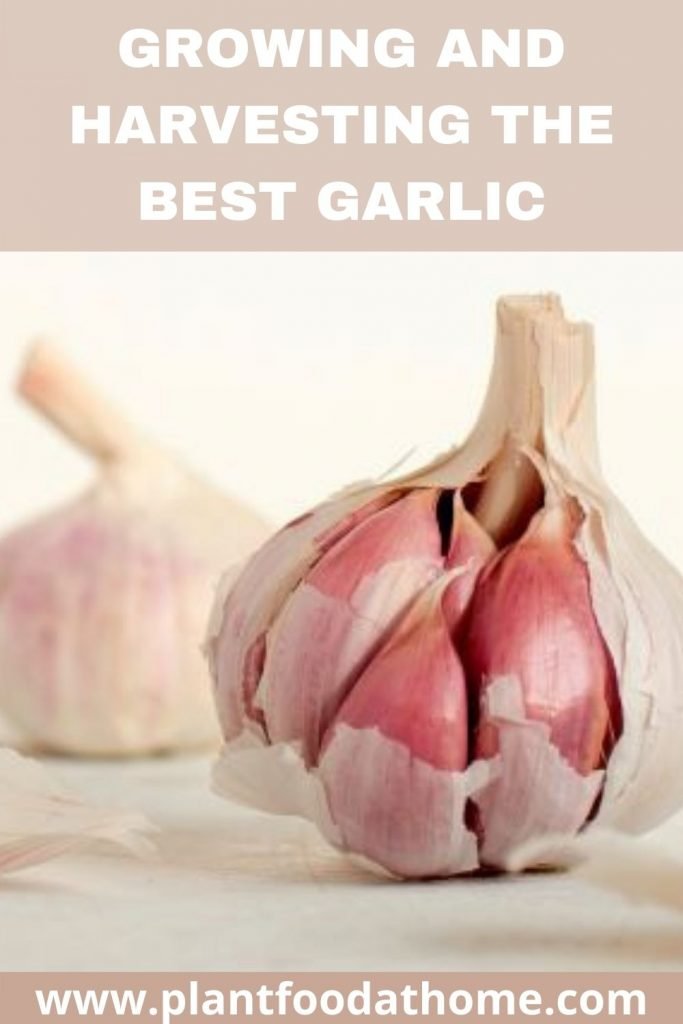Do you love the idea of growing your own garlic but not sure how to go about it? You’ve come to the right place. Find out how to grow garlic here, where we guide you through growing and harvesting the best garlic at home.
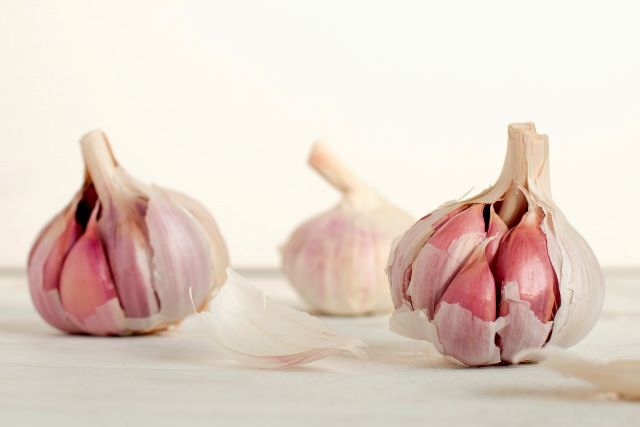
First, let me reassure you that garlic is very easy to grow. One of the biggest challenges is having enough patience for them to grow as they need a longish growing season of around 8 months.
Although I was interested in growing garlic for some time, it wasn’t until my young daughter took it upon herself to plant a sprouted supermarket store garlic clove in the veggie garden, that I really paid attention. At the end of 8 or so months of growing her one garlic glove, we harvest one perfect garlic bulb, much to the delight of my daughter! And I realized just how easy garlic is to grow. So here’s how you can grow your own garlic too.
Table of Contents
Garlic Plant Profile and Origins
Garlic is a perennial flowering plant that grows from a bulb. It has a tall flowering stem that grows up to 3ft (91cm). The leaves are long and linear and produce pink to purple flowers. It has a strong, pungent smell and the bulb has thin layers of sheaths enfolding the clove. A bulb may have 5-10 cloves depending on the variety.
Garlic, also known as Allium Sativum, is a species in the onion family. It originated from Central Asia and is commonly used worldwide as a seasoning. Also part of the same family are onions, shallots, leeks, and chives. Its name derives from the word garlēac which means a spear-shaped leek.
Popular Garlic Varieties
Garlic has approximately 700 species. However, there are two main types of garlic; Softneck Garlic and Hardneck Garlic.
The common garlic types that are sold in the supermarkets are artichoke and silverskin, which are both softnecked garlic. This type of garlic has soft necks that stay soft after harvesting them. They are well suited for warmer climates and this type of garlic also has a strong and intense flavor.
Hardneck garlic varieties produce flowering stems called scapes. These scapes need to be removed to promote the growth of the bulb. Scapes can be used in salads and in other dishes. Its flavor is milder than the softneck varieties. The most common hardneck types are Korean Red, Chesnok Red, Siberian, German White, Polish Hardneck, Persian Star, Purple Stripe, Porcelain, and Spanish Roja. They grow well in cold climates.
Although not a true garlic, the Great-Headed Garlic or Elephant Garlic is similar to a hardneck type. Despite its big size, it has a mild flavor, more like an onion and is closely related to leeks.
How to Grow Garlic
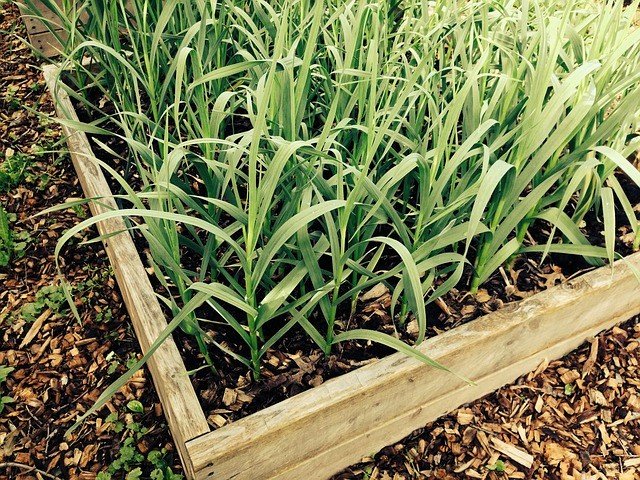
Climate
Garlic is easy to grow. They can be planted either spring or fall. Garlic that is planted in fall will produce bigger bulbs and cloves than those planted in spring. Cool temperature is needed from 32-50°F (0-10°C) during the first couples of months to encourage growth and a healthy root system.
Soil
Garlic thrives well in loose and well-drained rich soil with a pH of 6.5 to 7 (you can check this with a pH soil gauge here). It’s also best to add healthy compost and aged unprocessed animal manure. Mulching can raise the garden beds which helps promote good drainage. You can also help prepare the soil by adding in a couple of tablespoons of 5-10-10 complete fertilizer, inches below the base where the garlic will sit.
Sun
Garlic needs full sun. Although it can tolerate partial shade as long as it’s not for a long period of time during the day or the whole planting season.
Water
Water garlic twice a week as they need to be kept moist for the roots to develop. Do not over water them though as they may not grow well or it can cause rotting during colder months.
Refrain from additional watering during frequent rain and potentially increase watering in very warm conditions.
How to Grow Garlic Bulbs from Cloves
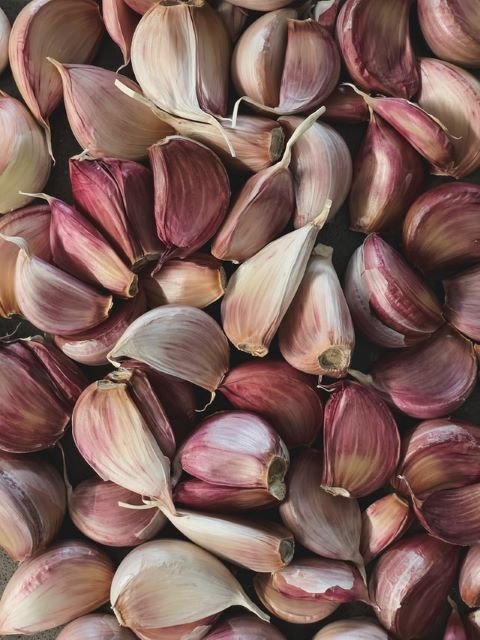
There are two options when planting garlic. You can plant them in late autumn about 4 to 6 weeks before the ground freezes. Planting in early spring is another option.
Before starting to plant garlic, it’s best to prepare the soil first by cultivating and adding some organic fertilizer or compost with well-rotted manure.
Be sure to purchase garlic cloves from a seed company or a plant nursery, instead of using those from groceries or supermarkets. These are usually treated to prolong their shelf life, making them hard to impossible to grow. Alternatively, you can use organically grown garlic, which I personally have done successfully.
When selecting garlic to plant, choose the large, firm, and healthy cloves so you can get a healthier and bigger bulb during harvest.
Prepare the garlic cloves by breaking them apart from the bulb, making sure to keep the papery layers on each clove as intact as possible. This is a protective layer and will minimize the risk of the clove rotting.
Plant them 4 inches (10 cm) apart and about 1 inch deep so they are just below the surface. Plant the clove in an upright position so the pointed end is facing up. If planting garlic in rows, make rows about 6 inches (15cm) apart.
When planting in late autumn, the shoots will emerge in early spring. While planting them in early spring, they will sprout in about 2 weeks.
How to Grow Garlic in Pots
Garlic can easily be grown in pots or containers. This is especially beneficial if garden space is limited or you are gardening on a balcony.
- To grow garlic in pots, prepare a large pot or container with good drainage.
- Fill the pot or container with a good quality organic potting mix, leaving 2-3 inches (5-7 cm) from the top. Using a potting mix with fertilizer already included or add in a slow-release fertilizer.
- Gently break the garlic cloves from the bulb, keeping the papery thin layers intact.
- Place the cloves with the pointed end facing up, about 1 inch deep so they are just below the surface, and 4 inches (10 cm) apart.
- Pat the soil down and water in gently.
- Place the pot or container in an area with full sun or in an area that gets at least 6 hours of direct sunlight during the day.
- Keep the soil moist but make sure there is good drainage to avoid wet and soggy soil.
- Use an organic mulch to keep the soil from drying out.
How Long Does It Take to Grow Garlic?
It takes 7 to 8 months for garlic to mature in ideal growing conditions.
Most garlic needs a long growing time with at least 40 to 60 days with temperatures under 40º F (104º C) for the clove to form a bulb. The clove starts to split into several new cloves and develops into a bulb.
When and How to Harvest Garlic
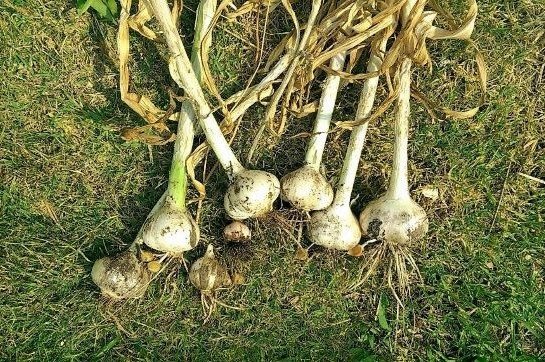
Garlic signals when it’s ready for harvest around 8 months after planting. The leaves around the bottom of the stalk will begin to dry out and turn brown as well as the tips of the taller leaves.
Harvesting garlic too soon will result in garlic cloves being small and not fully developed. And if garlic is left too long, the heads will start to dry up and the cloves will separate and rot.
So it might sound a bit daunting to get the harvest right at first. Especially because garlic has a long growing season. But it’s really not. Wait for the garlic to show signs of dying back by the browning of the lower leaves, calculate the amount of time the garlic has been growing and then if all signs point to the garlic being ready, go ahead and dig up one. Then if the garlic looks mature and healthy you can proceed with harvesting the rest of your garlic crop.
To harvest your garlic, carefully dig up the bulbs, not pulling them which could otherwise damage them. Then lift them from the ground, gently shaking to brush off the soil.
A good tip here is to stop watering the garlic for about a week before you intend to harvest them. This will help the soil to be dry and the job of harvesting will be easier and cleaner!
If there is still a lot of soil around the roots after harvest, spread the garlic out and allow them to dry out of direct sun for a few days. Then the soil can be gently brushed from the garlic in order to move on to curing and storing the garlic.
Curing and Storing Garlic
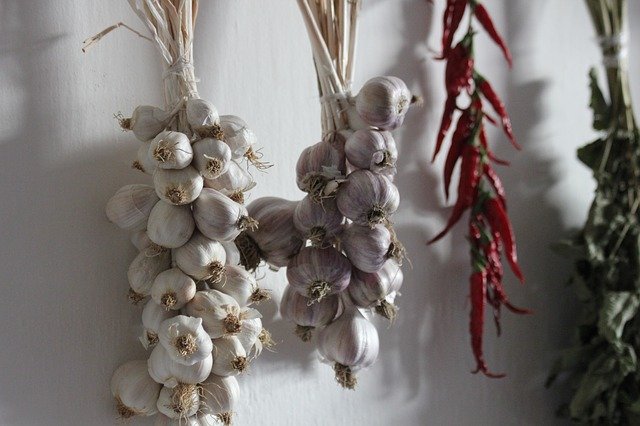
After harvest, garlic can be hung up in small bunches, with their stalks and roots intact, in a well-ventilated area until they are thoroughly dry. This can take 14 to 21 days. This process allows the garlic to fully dry which will help store the garlic for a longer time.
Once the garlic is dry, it can now be stored. There are two ways to store them, either through cutting the roots and leaves or by braiding the tops into strings. Though usually, hardneck varieties won’t braid because of their harder stalks. So a good idea for storing them is in wire kitchen baskets after they have been trimmed by removing the stalk, cutting an inch or two above the bulk and removing the roots.
Garlic should be stored in a cool, dry, airy place.
Properly stored garlic should last until the next planting season. The softneck variety will store longer than hardneck at around 6 months. While hardneck garlic will keep for 3-4 months.
Hold back some of your garlic harvest to be planted for the next season. Select the healthiest and largest garlic for replanting and you will have lovely big garlic for the following season.
Pests and Diseases
Garlic is considered a natural pest repellent. However, they still get problems with a few pests in the garden. They are struck by the same pests that feed on plants in the onion family such as aphids, mites, leaf miners, nematodes, and thrips. These can be easily controlled by using organic insecticides, horticultural neem oil, or simply getting rid of affected plants to avoid the spread of pests and diseases.
One main disease that affects garlic is White Rot. It is a fungus that attacks garlic in cool weather, affecting the leaves and the roots. The best solution to this is practicing crop rotation, cleaning up the garden beds after harvest, and preparing the soil with composts and well-rotted manure before planting to keep the soil healthy.
Conclusion
Although garlic has a long growing season, they are very low maintenance and the rewards are worth it. You’ll have delicious garlic, free from pesticides, which you can store and use until the next season. So which variety of garlic will you grow?
Recommended products
- Organic Vegetable Garden Fertilizer
- Soil pH, Water and Light Gauge
- Organic Potting Mix
- Horticultural Neem Oil
Further reading:
- How to Grow Lemongrass: Planting and Growing Guide
- Turmeric and Make Your Own Turmeric Powder
- 16 Vegetables You Can Regrow From Kitchen Scraps
- How To Grow Ginger: Guide To Growing Ginger At Home
- Growing Bulb Onions: 20 Things You Should Know
- Curry Leaf Plant: Growing, Caring and Eating Curry Leaves
- Horseradish Dying? Common Causes and Solutions
- Tips to get Asparagus to Come Up: Growing Tips
- Why Is My Ginger Plant Dying? Causes and Solutions
